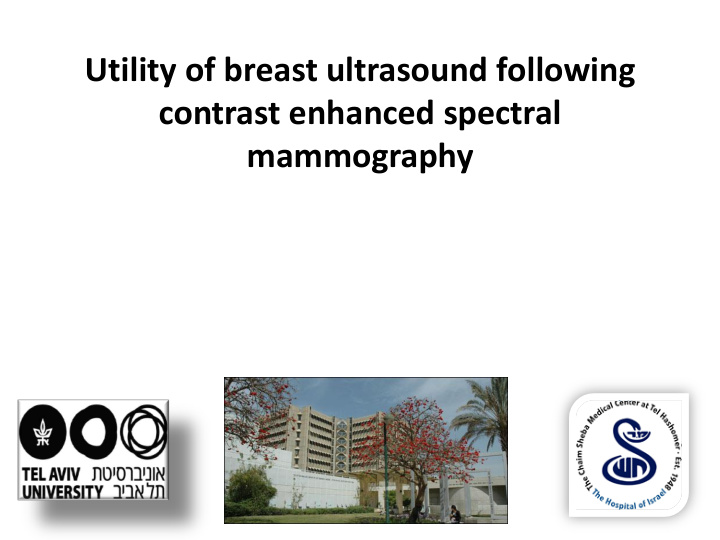



Utility of breast ultrasound following contrast enhanced spectral mammography
• Authors have nothing to declare
Introduction • Breast cancer • Mammography • Ultrasound • Contrast mammography
Introduction • Breast cancer – most commonly diagnosed cancer among women • Mammography • Ultrasound • Contrast mammography
Introduction • Breast cancer • Mammography – most common breast cancer screening test • Ultrasound • Contrast mammography
Introduction • Breast cancer • Mammography • Ultrasound – highly sensitive, but increased rate of false positive diagnoses • Contrast mammography
Introduction • Breast cancer • Mammography – Anatomic Imaging • Ultrasound – Anatomic Imaging • Contrast mammography – mostly unaffected by dense breast tissue – Anatomic and functional imaging
Purpose • To evaluate if breast ultrasound is routinely indicated following contrast mammography
Materials and methods • Women who underwent contrast mammography and breast ultrasound at Sheba’s Meirav Women’s Imaging Center were retrospectively collected (2012 – 2016)
Materials and methods • Both contrast mammography BIRADS scores and ultrasound BIRADS scores were grouped into three categories: – Benign appearance (BIRADS 1,2) – Follow-up (BIRADS 3) – Suspicious (BIRADS 0,4,5)
Materials and methods • The association between Suspicious Test Result and Malignant Biopsy were calculated for Ultrasound and Contrast Mammography
Results • 953 women underwent contrast mammography • Ultrasound were conducted for 828 right breasts and 841 left breasts • 87 (5.2%) breasts were biopsied • 37/87 (42.5%) biopsies were malignant
Results – Malignant Biopsies • In the 37 malignant biopsies: – None of the malignant biopsies had a benign appearing contrast mammography – 1/37 (2.7%) had a Follow-up contrast mammography and Suspicious ultrasound
Results – Benign Biopsies • In the 50 benign biopsies: – 46/50 (92%) had a suspicious appearing ultrasound – 30/50 (60%) had a suspicious appearing contrast mammography
Results • Contrast mammography is more sensitive and more specific than ultrasound • While Suspicious contrast mammography was associated with malignant biopsies (p<0.0001, Odds Ratio=24.0) • Suspicious ultrasound was not (p=0.985, Odds Ratio=0.9)
Conclusion • When the contrast mammography shows a BIRADS 0,4,5 we suggest performing ultrasound-guided biopsy • With contrast mammography BIRADS 3 we suggest correlation with ultrasound • If the contrast mammography is Benign Appearing (BIRADS 1,2) routine use of ultrasound is questionable as it may lead to unnecessary biopsies
Conclusion • When the contrast mammography shows a BIRADS 0,4,5 we suggest performing ultrasound-guided biopsy • With contrast mammography BIRADS 3 we suggest correlation with ultrasound • If the contrast mammography is Benign Appearing (BIRADS 1,2) routine use of ultrasound is questionable as it may lead to unnecessary biopsies
Conclusion • When the contrast mammography shows a BIRADS 0,4,5 we suggest performing ultrasound-guided biopsy • With contrast mammography BIRADS 3 we suggest correlation with ultrasound • If the contrast mammography is Benign Appearing (BIRADS 1,2) routine use of ultrasound is questionable as it may lead to unnecessary biopsies
needle Contrast Mammography Ultrasound-guided breast biopsy (benign appearing) Thank You Alec Krosser Email: aleckrosser@gmail.com
Recommend
More recommend